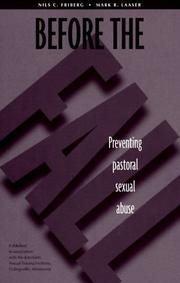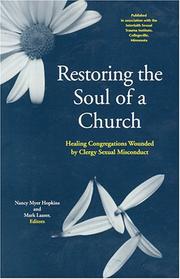| Listing 1 - 10 of 22 | << page >> |
Sort by
|

ISBN: 0814623913 Year: 1998 Publisher: Collegeville Liturgical Press
Abstract | Keywords | Export | Availability | Bookmark
 Loading...
Loading...Choose an application
- Reference Manager
- EndNote
- RefWorks (Direct export to RefWorks)
Book
ISBN: 885758674X 9788857586748 Year: 2022 Publisher: Milano: Mimesis,
Abstract | Keywords | Export | Availability | Bookmark
 Loading...
Loading...Choose an application
- Reference Manager
- EndNote
- RefWorks (Direct export to RefWorks)
Sexual misconduct by clergy --- Child sexual abuse --- Sex crimes --- Pedophilia
Book
ISBN: 3031459989 Year: 2024 Publisher: Cham : Palgrave Macmillan,
Abstract | Keywords | Export | Availability | Bookmark
 Loading...
Loading...Choose an application
- Reference Manager
- EndNote
- RefWorks (Direct export to RefWorks)
Allison Niebauer's 'The Diocese’s Darkest Chapter' explores the cultural trauma resulting from the Catholic Church abuse crisis in America. Through empirical research, including archives, media, and interviews, the book examines how narratives and rhetoric shape societal understanding of this crisis. Niebauer highlights the role of common topoi—shared cultural references—and rhetorical strategies used by stakeholders to address accusations and defenses within the Church. The work contributes to cultural sociology by integrating rhetorical studies and cultural trauma theories, providing insights into the social construction of trauma. Intended for scholars of sociology, cultural studies, and religious studies, the book emphasizes the ongoing impact of the crisis on society and institutions.
Book
ISBN: 9783643501639 Year: 2010 Publisher: Wien LIT
Abstract | Keywords | Export | Availability | Bookmark
 Loading...
Loading...Choose an application
- Reference Manager
- EndNote
- RefWorks (Direct export to RefWorks)
Sexual misconduct by clergy --- Sex --- Religious aspects --- Catholic Church --- Catholic Church --- Clergy --- Sexual behavior.

ISBN: 0814623336 Year: 1995 Publisher: Collegeville Liturgical Press
Abstract | Keywords | Export | Availability | Bookmark
 Loading...
Loading...Choose an application
- Reference Manager
- EndNote
- RefWorks (Direct export to RefWorks)
Reconciliation --- Sexual abuse victims --- Sexual misconduct by clergy --- Religious aspects --- Christianity --- Pastoral counseling of
Book
ISBN: 9781032512860 1032512849 9781032512846 Year: 2024 Publisher: Abingdon, Oxon New York, NY Routledge, Taylor & Francis Group
Abstract | Keywords | Export | Availability | Bookmark
 Loading...
Loading...Choose an application
- Reference Manager
- EndNote
- RefWorks (Direct export to RefWorks)
This book addresses the crisis of sexual abuse in the Roman Catholic Church in Latin America, the region of the world with the highest percentage of Catholics. Bringing together research from across the continent, it demonstrates that abuse within the Church is indeed a global phenomenon, though abuses have taken different forms according to varying sociocultural contexts. With attention to abuses committed against children, women and vulnerable adults - by both men and women - within the settings of parishes, new religious movements and international religious organizations, it also raises questions of justice, asking how to assess the suffering of victims, how to deal with abusers and how to prevent abuses. It will therefore be of interest to scholars of religious studies, sociology, Latin American studies, criminology, theology, and religious leaders with interests in the abuses and scandals that have been revealed in the worldwide Church.
Sexual misconduct by clergy --- Child sexual abuse by clergy --- Catholic Church --- Clergy --- Sexual behavior
Book
ISBN: 9780718895624 0718895622 9780718848194 9780718848200 Year: 2021 Publisher: Cambridge Lutterworth Press
Abstract | Keywords | Export | Availability | Bookmark
 Loading...
Loading...Choose an application
- Reference Manager
- EndNote
- RefWorks (Direct export to RefWorks)
Given their rhetoric on safeguarding, the response of religious organisations to abuse by the clergy - sexual, physical and spiritual - has been inept, thoughtless, mean, and without any sense of urgency. Sex, Power, Control explores the underlying reasons for the mishandling of recent abuse cases. Using psychoanalytical and sociological insights, and including her own experiences as shown in the BBC documentary Exposed: The Church's Darkest Secret, Gardner asks why the Churches find themselves in such a crisis, and how issues of power and control have contributed to secrecy, deception and heartache. Drawing on survivor accounts and delving into the psychology of clergy abusers, she reveals a culture of avoidance and denial, while an examination of power dynamics highlights institutional narcissism and a hierarchical structure based on deference, with defensive assumptions linked to sex, gender and class. Sex, Power, Control is an invaluable resource for all those in the church or similar institutions, and for anyone concerned about child abuse.
Child sexual abuse by clergy --- Sexual misconduct by clergy --- Clergy --- Religious aspects --- Church of England --- Sexual behavior --- Church of England
Book

ISBN: 3110699206 Year: 2021 Publisher: Berlin ; Boston : De Gruyter,
Abstract | Keywords | Export | Availability | Bookmark
 Loading...
Loading...Choose an application
- Reference Manager
- EndNote
- RefWorks (Direct export to RefWorks)
Der Umgang mit sexualisierter Gewalt in kirchlichen Kontexten ist unzureichend. Zwar wurden Maßnahmen zur Intervention und Prävention unternommen, spezifische kirchliche und theologische Ermöglichungsbedingungen sind aber noch zu wenig beachtet worden. Bisher fehlen interdisziplinäre und interkonfessionelle Studien zum Problem des Vorfeldes sexualisierter Gewalt in kirchlichen Kontexten. Dabei geht es um Theologien und Strukturen, die in ihrer Ambivalenz einen Bezug zur sexualisierten Gewalt aufweisen und Reaktionspflichten hemmen.Diese Blickbegrenzung soll im Gespräch zwischen verschiedenen theologischen Fächern (Bibelwissenschaften, Ethik, Pastoral- und Religionspsychologie) und anderen relevanten Disziplinen (Geschichtswissenschaften, Psychologie, Kriminologie) überwunden werden, um ein kritisches Denken und Handeln in Theologie und Kirche im Bewusstsein der Persistenz spezifischer Formen sexualisierter Gewalt und etablierter Reaktionsformen zu entwickeln.Gemeinsames Ergebnis der einzelnen Studien dieses Bandes ist, dass die Berücksichtigung der Erfahrung sexualisierter Gewalt im Kontext kirchlicher Institutionen die Akzeptanz zugrundeliegender theologischer und seelsorglicher Annahmen ändert. Religious settings have specifically proven to be potential places of sexual violence in the absence of adequate protection of bodily and psychological integrity. In an interdisciplinary and interdenominational conversation, basic religious factors are analyzed that cause specific patterns of abuse and lead to the failure of duties of protection.
Book
ISBN: 9780812252521 0812252527 0812297482 9780812297485 Year: 2020 Publisher: Philadelphia
Abstract | Keywords | Export | Availability | Bookmark
 Loading...
Loading...Choose an application
- Reference Manager
- EndNote
- RefWorks (Direct export to RefWorks)
In the fourth century, clerics began to distinguish themselves from members of the laity by virtue of their augmented claims to holiness. Because clerical celibacy was key to this distinction, religious authorities of all stripes--patristic authors, popes, theologians, canonists, monastic founders, and commentators--became progressively sensitive to sexual scandals that involved the clergy and developed sophisticated tactics for concealing or dispelling embarrassing lapses. According to Dyan Elliott, the fear of scandal dictated certain lines of action and inaction, the consequences of which are painfully apparent today. In The Corrupter of Boys, she demonstrates how, in conjunction with the requirement of clerical celibacy, scandal-averse policies at every conceivable level of the ecclesiastical hierarchy have enabled the widespread sexual abuse of boys and male adolescents within the Church. Elliott examines more than a millennium's worth of doctrine and practice to uncover the origins of a culture of secrecy and concealment of sin. She charts the continuities and changes, from late antiquity into the high Middle Ages, in the use of boys as sexual objects before focusing on four specific milieus in which boys and adolescents would have been especially at risk in the high and later Middle Ages: the monastery, the choir, the schools, and the episcopal court. The Corrupter of Boys is a work of stunning breadth and discomforting resonance, as Elliott concludes that the same clerical prerogatives and privileges that were formulated in late antiquity and the medieval era--and the same strategies to cover up the abuses they enable--remain very much in place.
Celibacy --- Child sexual abuse by clergy --- Child sexual abuse by clergy. --- Church history --- Clergy --- Sexual misconduct by clergy --- Sexual misconduct by clergy. --- Christianity --- History --- Christianity. --- Middle Ages. --- Primitive and early church. --- Sexual behavior --- Sexual behavior. --- To 1500. --- E-books --- Pédophilie --- Chasteté --- Moyen Age
Book
ISBN: 2859397809 9782859397807 2757426753 Year: 2020 Volume: *6 Publisher: Villeneuve d'Ascq : Presses universitaires du Septentrion,
Abstract | Keywords | Export | Availability | Bookmark
 Loading...
Loading...Choose an application
- Reference Manager
- EndNote
- RefWorks (Direct export to RefWorks)
Le charme indiscret est une histoire éternelle, remplie de sentiments universels – amitié, amour, joie, gravité, désespoir, méfiance – … et de sexe. Le récit commence le jour même de la proclamation du Traité de Westphalie (1648), qui met un terme à la Guerre de Quatre-Vingts Ans entre le Roi d’Espagne et les États de Hollande. Dans l’euphorie des festivités, Jan Schuermans, intelligent et sémillant curé d’Ename, paisible village de Flandre, faisant fi de la pruderie de son époque, se laisse aller à coucher avec une jeune femme. Les circonstances sont floues. S’agit-il de séduction ou de viol ? Quoi qu’il en soit, un enfant naît presque huit mois plus tard et meurt quelques jours après. Ce décès n’empêche pas la machine judiciaire ecclésiastique de s’acharner à l’enquête. Poursuivi, Jan Schuermans se réfugie à L’Écluse (Sluis), ville devenue hollandaise en vertu du Traité. Or, voici qu’on découvre d’autres scandales impliquant une moniale et des femmes du village. Condamné et chassé de son village, notre curé se retrouve en fâcheuse posture à Dunkerque, juste au moment de la Bataille des Dunes, repart sur les routes de l’exil et finit ses jours dans les parages de Furnes. Toute sa vie n’est qu’une longue succession d’ambitions frustrées, d’humiliations profondes et de poursuites acharnées. L’auteur excelle à brosser cette tragique « petite histoire » personnelle sur fond d’Histoire avec un grand H. Il évoque d’une part le curé et sa clique d’amis et amies, de l’autre les grands événements de ce dix-septième siècle, dont le dépeçage de la Flandre, disputée entre l’Espagne, la France et les Provinces-Unies. L’auteur exploite un éventail de documents étonnamment riche et varié pour retracer les faits certes mais avant tout pour pénétrer la psychologie des personnages. Il dénonce en même temps la mesquinerie de la Contre-Réforme avec son cortège de haines et de suspicions. Lancinantes, ces paroles de Jan Schuermans : « Je ne voulais pas de quelque chose de vivant ».
Pays-Bas espagnols --- --Vie quotidienne --- --Clergé --- --XVIIe s., --- Schuermans, Jan --- --Sexual misconduct by clergy --- Catholic Church --- Abdij van Ename --- Clergy --- History --- Flemish history --- 17th century --- Biographical essay --- Sexual misconduct by clergy --- Curé --- Histoire --- Libertinage --- 17e siècle. --- Curé. --- Histoire. --- Libertinage. --- Clergy sexual misconduct --- Sexual misconduct --- Sexual behavior --- Schuermans, Jan. --- Ename (Belgium). --- Flanders (County) --- Biography --- Vie quotidienne --- Clergé --- XVIIe s., 1601-1700 --- Sexual misconduct by clergy - Belgium - Ename - Case studies --- Curé --- 17e siècle --- Schuermans, Jan, --- FLANDRE (BELGIQUE) --- PAYS-BAS --- SEXUALITE --- MOEURS ET COUTUMES --- HISTOIRE --- 17E SIECLE --- Moeurs et coutumes
| Listing 1 - 10 of 22 | << page >> |
Sort by
|

 Search
Search Feedback
Feedback About UniCat
About UniCat  Help
Help News
News